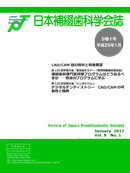Volume 9, Issue 4
October 2017
Displaying 1-25 of 25 articles from this issue
- |<
- <
- 1
- >
- >|
Invited Articles
Functional recovery in removable partial prosthodontics
-
2017 Volume 9 Issue 4 Pages 277-278
Published: 2017
Released on J-STAGE: October 21, 2017
Download PDF (370K) -
2017 Volume 9 Issue 4 Pages 279-284
Published: 2017
Released on J-STAGE: October 21, 2017
Download PDF (841K) -
2017 Volume 9 Issue 4 Pages 285-290
Published: 2017
Released on J-STAGE: October 21, 2017
Download PDF (937K) -
2017 Volume 9 Issue 4 Pages 291-296
Published: 2017
Released on J-STAGE: October 21, 2017
Download PDF (2028K) -
2017 Volume 9 Issue 4 Pages 297-302
Published: 2017
Released on J-STAGE: October 21, 2017
Download PDF (806K)
Oral Rehabilitation utilizing Several Types of Overdentures
-
2017 Volume 9 Issue 4 Pages 303
Published: 2017
Released on J-STAGE: October 21, 2017
Download PDF (338K) -
2017 Volume 9 Issue 4 Pages 304-310
Published: 2017
Released on J-STAGE: October 21, 2017
Download PDF (1789K) -
2017 Volume 9 Issue 4 Pages 311-316
Published: 2017
Released on J-STAGE: October 21, 2017
Download PDF (1109K) -
2017 Volume 9 Issue 4 Pages 317-325
Published: 2017
Released on J-STAGE: October 21, 2017
Download PDF (2368K) -
2017 Volume 9 Issue 4 Pages 326-331
Published: 2017
Released on J-STAGE: October 21, 2017
Download PDF (1336K)
Oral rehabilitation utilizing the special prosthesis
-
2017 Volume 9 Issue 4 Pages 332-333
Published: 2017
Released on J-STAGE: October 21, 2017
Download PDF (379K) -
2017 Volume 9 Issue 4 Pages 334-338
Published: 2017
Released on J-STAGE: October 21, 2017
Download PDF (908K) -
2017 Volume 9 Issue 4 Pages 339-344
Published: 2017
Released on J-STAGE: October 21, 2017
Download PDF (1514K) -
2017 Volume 9 Issue 4 Pages 345-350
Published: 2017
Released on J-STAGE: October 21, 2017
Download PDF (887K) -
2017 Volume 9 Issue 4 Pages 351-356
Published: 2017
Released on J-STAGE: October 21, 2017
Download PDF (1433K)
Original Articles
-
2017 Volume 9 Issue 4 Pages 357-364
Published: 2017
Released on J-STAGE: October 21, 2017
Download PDF (784K) -
2017 Volume 9 Issue 4 Pages 365-373
Published: 2017
Released on J-STAGE: October 21, 2017
Download PDF (939K) -
2017 Volume 9 Issue 4 Pages 374-382
Published: 2017
Released on J-STAGE: October 21, 2017
Download PDF (1140K)
Case Reports (Specialist)
-
2017 Volume 9 Issue 4 Pages 383-386
Published: 2017
Released on J-STAGE: October 21, 2017
Download PDF (661K) -
2017 Volume 9 Issue 4 Pages 387-390
Published: 2017
Released on J-STAGE: October 21, 2017
Download PDF (687K) -
2017 Volume 9 Issue 4 Pages 391-394
Published: 2017
Released on J-STAGE: October 21, 2017
Download PDF (738K) -
2017 Volume 9 Issue 4 Pages 395-398
Published: 2017
Released on J-STAGE: October 21, 2017
Download PDF (950K) -
2017 Volume 9 Issue 4 Pages 399-402
Published: 2017
Released on J-STAGE: October 21, 2017
Download PDF (665K) -
2017 Volume 9 Issue 4 Pages 403-406
Published: 2017
Released on J-STAGE: October 21, 2017
Download PDF (685K)
Erratum
-
Article type: Erratum
2017 Volume 9 Issue 4 Pages 411
Published: 2017
Released on J-STAGE: October 21, 2017
Download PDF (108K)
- |<
- <
- 1
- >
- >|
